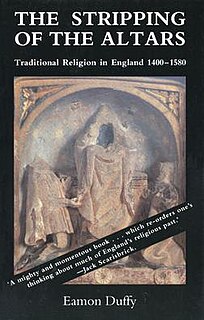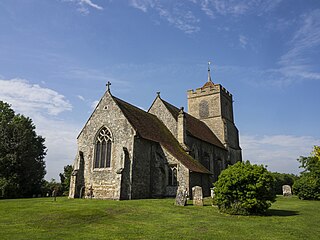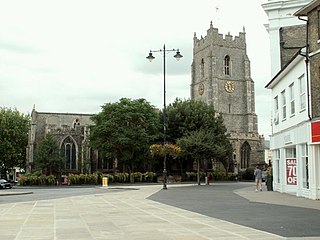
In Eastern Christianity, an iconostasis is a wall of icons and religious paintings, separating the nave from the sanctuary in a church. Iconostasis also refers to a portable icon stand that can be placed anywhere within a church. The iconostasis evolved from the Byzantine templon, a process complete by the 15th century.

Eamon Duffy is an Irish historian. He is a professor of the history of Christianity at the University of Cambridge, and a Fellow and former president of Magdalene College.

The rood screen is a common feature in late medieval church architecture. It is typically an ornate partition between the chancel and nave, of more or less open tracery constructed of wood, stone, or wrought iron. The rood screen would originally have been surmounted by a rood loft carrying the Great Rood, a sculptural representation of the Crucifixion. In English, Scottish, and Welsh cathedrals, monastic, and collegiate churches, there were commonly two transverse screens, with a rood screen or rood beam located one bay west of the pulpitum screen, but this double arrangement nowhere survives complete, and accordingly the preserved pulpitum in such churches is sometimes referred to as a rood screen. At Wells Cathedral the medieval arrangement was restored in the 20th century, with the medieval strainer arch supporting a rood, placed in front of the pulpitum and organ.

An Easter Sepulchre is a feature of British church interior architecture.

The Stripping of the Altars: Traditional Religion in England, 1400–1580 is a work of history written by Eamon Duffy and published in 1992 by Yale University Press. It received the Longman-History Today Book of the Year Award.

St Edith's Church, Shocklach, stands at the end of an isolated lane running toward the River Dee about 1 mile (2 km) to the north of the village of Shocklach, Cheshire, England. It is a small Norman church, and is one of the oldest ecclesiastical buildings in Cheshire. The church is recorded in the National Heritage List for England as a designated Grade I listed building and its simple Norman work is considered to be unique in Cheshire. It is an active Anglican parish church in the diocese of Chester, the archdeaconry of Chester and the deanery of Malpas. Its benefice is combined with that of St Mary, Tilston.

St Alban's Church in Macclesfield, Cheshire, England, is a Roman Catholic parish church. The church is recorded in the National Heritage List for England as a designated Grade II* listed building. It was designed by A. W. N. Pugin and is described as a "church of exceptional interest among the works of this major architect".

St Patrick's Church, Patrington is an Anglican parish church located in Patrington, East Riding of Yorkshire, England. The church is a Grade I listed building.

All Saints' Church is a redundant Anglican church in the village of Icklingham, Suffolk, England. It is recorded in the National Heritage List for England as a designated Grade I listed building, and is under the care of the Churches Conservation Trust. The church stands in the highest point in the village, adjacent to the A1101 road between Mildenhall and Bury St Edmunds. This was formerly the ancient trackway of Icknield Way, and Icklingham is close to an important junction on this trackway.

St Margaret's Church is a redundant Anglican church in the village of Hales, Norfolk, England. It is recorded in the National Heritage List for England as a designated Grade I listed building, and is under the care of the Churches Conservation Trust. The church stands in open fields to the south of the village and to the east of the A146 road.

All Saints Church is a redundant Anglican church in the village of Theddlethorpe All Saints, Lincolnshire, England. It is recorded in the National Heritage List for England as a designated Grade listed building, and is under the care of the Churches Conservation Trust. The church stands to the east of the A1031 road in the area of the village named Theddlethorpe All Saints, and is some 3 miles (5 km) northeast of Mablethorpe. It has been called the "Cathedral of the Marsh".

All Saints Church is a redundant Anglican church in the village of Little Wenham, Suffolk, England. It is recorded in the National Heritage List for England as a designated Grade I listed building, and is under the care of the Churches Conservation Trust. It stands in an isolated position close to Little Wenham Hall, about 0.6 miles (1 km) to the northwest of Capel St. Mary.

St Andrew's Church is a redundant Anglican church in the village of Buckland, Hertfordshire, England. It is recorded in the National Heritage List for England as a designated Grade II* listed building, and is under the care of the Churches Conservation Trust. The church stands at the highest point in the village to the east of Ermine Street, now the A10 road, between Royston and Buntingford.

All Saints Church is a partly redundant Anglican church in the village of Newton Green, Suffolk, England. It is recorded in the National Heritage List for England as a designated Grade II* listed building. The chancel is still in use for worship, but the nave, porch and tower are redundant and vested in the care of the Churches Conservation Trust. The church stands towards the north of the village, some two miles east of Sudbury.

St Peter'sChurch, Sudbury is a former Anglican church in the town of Sudbury, Suffolk, England, which now serves as a cultural venue. The building is recorded in the National Heritage List for England as a designated Grade I listed building, and is under the care of the Churches Conservation Trust. The building stands in the heart of the town in a dominating position on Market Hill.

St Lawrence's Church is a redundant Anglican church in Broughton, Milton Keynes, Buckinghamshire, England. The church is recorded in the National Heritage List for England as a designated Grade I listed building, and is under the care of the Churches Conservation Trust. The church stands on the eastern periphery of Milton Keynes, between the A4146 and (former) A5130 roads. It is listed at Grade I because of its "remarkable series" of medieval wall paintings.

St Oswald's Church is in Church Road, Worleston, Cheshire, England. It is an active Anglican parish church in the deanery of Nantwich, the archdeaconry of Macclesfield, and the diocese of Chester. Its benefice is combined with those of St Mary, Acton, St Bartholomew, Church Minshull, and St David, Wettenhall. The church is recorded in the National Heritage List for England as a designated Grade II listed building.

St Mary and St Michael's Church is in the village of Great Urswick, Cumbria, England. It is an active Anglican parish church in the deanery of Furness, the archdeaconry of Westmorland and Furness, and the diocese of Carlisle. Its benefice is united with those of St Cuthbert, Aldingham, St Matthew, Dendron, and St Michael, Rampside. These churches are part of a group known as the Low Furness Group of Parishes. The church is recorded in the National Heritage List for England as a designated Grade I listed building.

All Saints Church is in the village of Claverley, Shropshire, England. It is an active Anglican parish church in the deanery of Bridgnorth, the archdeaconry of Ludlow, and the diocese of Hereford. Its benefice is united with that of Holy Innocents, Tuck Hill. The church is recorded in the National Heritage List for England as a designated Grade I listed building.

St Edith's Church is in the village of Eaton-under-Heywood, Shropshire, England. It stands on the lower slopes of Wenlock Edge. The church, dedicated to Saint Edith of Wilton, is an active Anglican parish church in the deanery of Condover, the archdeaconry of Ludlow, and the diocese of Hereford. Its benefice is united with that of St Andrew, Hope Bowdler. The church is recorded in the National Heritage List for England as a designated Grade I listed building.





















